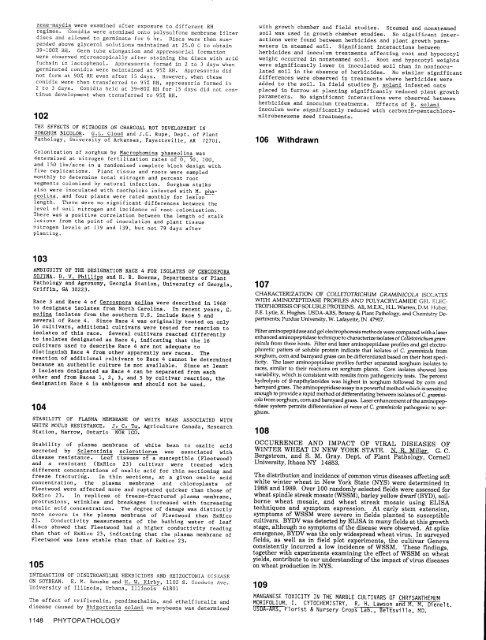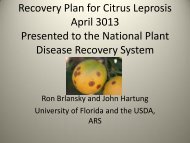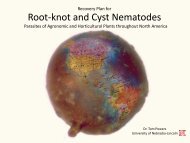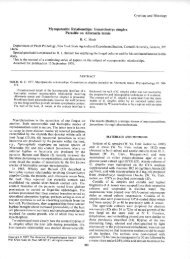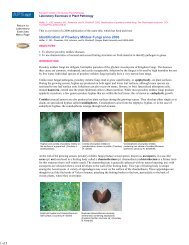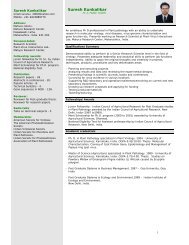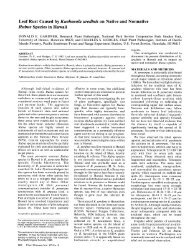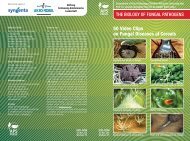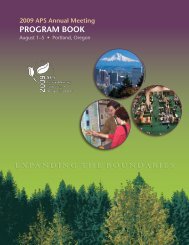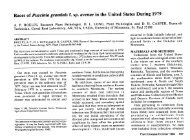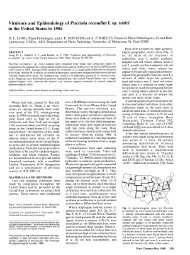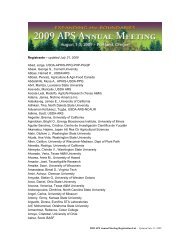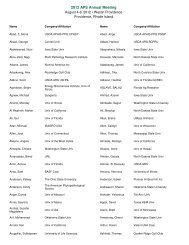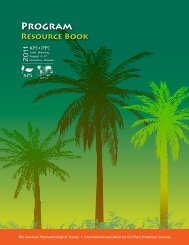view article - American Phytopathological Society
view article - American Phytopathological Society
view article - American Phytopathological Society
You also want an ePaper? Increase the reach of your titles
YUMPU automatically turns print PDFs into web optimized ePapers that Google loves.
zeae-maydis were examined after exposure to different RH with growth chamber and field studies. Steamed and nonsteamed<br />
regimes. Conidia were atomized onto polysulfone membrane filter soil was used in growth chamber studies. No significant interdiscs<br />
and allowed to germinate for 6 hr. Discs were then sus- actions were found between herbicides and plant growth parspended<br />
above glycerol solutions maintained at 25.0 C to obtain meters in steamed soil. Significant interactions between<br />
39-100% RH. Germ tube elongation and appressorial formation herbicides and inoculum treatments affecting root and hypocotyl<br />
were observed microscopically after staining the discs with acid weight occurred in nonsteamed soil. Root and hypocotyl weights<br />
fuchsin in lactophenol. Appressoria formed in 2 to 3 days when were significantly lower in inoculated soil than in noninocugerminated<br />
conidia were maintained at 95% RH. Appressoria did lated soil in the absence of herbicides. No similar significant<br />
not form at 90% RH even after 15 days. However, when these differences were observed in treatments where herbicides were<br />
conidia were then transferred to 95% RH, appressoria formed in added to the soil. In field studies R. solani infested oats<br />
2 to 3 days. Conidia held at 39-80% RH for 15 days did not con- placed in furrow at planting significantly reduced plant growth<br />
tinue development when transferred to 95% RH. parameters. No significant interactions were observed between<br />
herbicides and inoculum treatments. Effects of R. solani<br />
inoculum were significantly reduced with carboxin-pentachloro-<br />
102 nitrobenezene seed treatments.<br />
THE EFFECTS OF NITROGEN ON CHARCOAL ROT DEVELOPMENT IN<br />
SORGHUM BICOLOR. G.L. Cloud and J.C. Rupe, Dept. of Plant<br />
Pathology, University of Arkansas, Fayetteville, AR 72701. 106 Withdrawn<br />
Colonization of sorghum by Macrophomina phaseolina was<br />
determined at nitrogen fertilization rates of 0, 50, 100,<br />
and 150 lbs/acre in a randomized complete block design with<br />
five replications. Plant tissue and roots were sampled<br />
monthly to determine total nitrogen and percent root<br />
segments colonized by natural infection. Sorghum stalks<br />
also were inoculated with toothpicks infested with M. pLhaseolina,<br />
and four plants were rated monthly for lesion<br />
length. There were no significant differences between the<br />
level of soil nitrogen and incidence of root colonization.<br />
There was a positive correlation between the length of stalk<br />
lesions from the point of inoculation and plant tissue<br />
nitrogen levels at 119 and 139, but not 79 days after<br />
planting.<br />
103<br />
AMBIGUITY OF THE DESIGNATION RACE 4 FOR ISOLATES OF CERCOSPORA<br />
SOJINA. D. V. Phillips and H. R. Boerma, Departments of Plant<br />
Pathology and Agronomy, Georgia Station, University of Georgia, 107<br />
Griffin, GA 30223. CHARACTERIZATION OF COLLETOTRICHUM GRAMINICOLA ISOLATES<br />
Race 3 and Race 4 of Cercospora sojina were described in 1968 WITH<br />
TROPHORESIS<br />
AMINOPEPTIDASE<br />
OF SOLUBLE<br />
PROFILES AND<br />
PROTEINS.<br />
POLYACRYLAMIDE<br />
Ali,<br />
GEL<br />
M.E.K.,<br />
ELECto<br />
designate isolates from North Carolina. In<br />
H.L.<br />
recent<br />
Warren,<br />
years,<br />
D.M. Huter<br />
_C. E.tROPHORES sOFSOBLPR S A atholEgyH<br />
sojina<br />
anrenDMurI<br />
isolates from the southern U.S. include Race 5 and F.E. Lytle, K. Hughes. USDA-ARS, Botany & Plant Pathology,<br />
several<br />
and<br />
of<br />
Che0istry<br />
Race 4.<br />
De-<br />
Since Race 4 was originally tested on only partments; Purdue University, W.<br />
16<br />
Lafayette,<br />
cultivars,<br />
IN 47907.<br />
additional cultivars were tested for reaction to Filter aminopeptidase and gel electrophoresis methods<br />
isolates<br />
were compared<br />
of this<br />
with<br />
race.<br />
a laser<br />
Several cultivars reacted differently enhanced aminopeptidase technique to characterize<br />
to<br />
isolates<br />
isolates<br />
of Colletotrichum<br />
designated<br />
gram<br />
as Race 4, indicating that the 16 inicola from three hosts. Filter and laser aminopeptidase profiles<br />
cultivars<br />
and gel<br />
used<br />
electro-<br />
to describe Race 4 are not adequate to phoretic patters of soluble protein indicate that<br />
distinguish<br />
isolates of C. graminicola<br />
Race 4<br />
from<br />
from other apparently new races. The sorghum, corn and barnyard grass can be differentiated<br />
reaction<br />
based<br />
of<br />
on<br />
additional<br />
their host speci-<br />
cultivars to Race 4 cannot be determined ficity. The laser aminopeptidase profiles further separated<br />
because<br />
sorghum<br />
an<br />
isolates<br />
authentic<br />
to<br />
culture is not available. Since at least races, similar to their reactions on sorghum<br />
3 isolates<br />
plants. Corn<br />
designated<br />
isolates showed<br />
as Race<br />
less<br />
4 can be separated from each variability, which is consistent with results from pathogenicity<br />
other and<br />
tests.<br />
from<br />
The<br />
Races<br />
percent<br />
1, 2, 3, and 5 by cultivar reaction, the hydrolysis of f?-napthylamides was highest in sorghum<br />
designation<br />
followed<br />
Race<br />
by<br />
4<br />
corn<br />
is<br />
and<br />
ambiguous and should not be used. barnyard grass. The aminopeptidase assay is a powerful method which is sensitive<br />
104<br />
enough to provide a rapid method of differentiating between isolates of C. graminicola<br />
from sorghum, corn and barnyard grass. Laser enhancement of the aminopeptidase<br />
system permits differentiation of races of C. graminicola pathogenic to sorghum.<br />
STABILITY OF PLASMA MEMBRANE OF WHITE BEAN ASSOCIATED WITH<br />
WHITE MOULD RESISTANCE. J. C. Tu, Agriculture Canada, Research<br />
Station, Harrow, Ontario NOR IGO.<br />
Stability of plasma membrane of white bean to oxalic acid<br />
secreted by Sclerotinia eclerotiorum was associated with<br />
disease resistance. Leaf tissues of a susceptible (Fleetwood)<br />
and a resistant (ExRico 23) cultivar were treated with<br />
different concentrations of oxalic acid for thin sectioning and<br />
freeze fracturing. In thin sections, at a given oxalic acid<br />
concentration, the plasma membrane and chloroplasts of<br />
Fleetwood were affected more and ruptured quicker than those of<br />
ExRico 23. In replicas of freeze-fractured plasma membrane,<br />
protrusions, wrinkles and breakages increased with increasing<br />
oxalic acid concentration. The degree of damage was distinctly<br />
more severe in the plasma membrane of Fleetwood than ExRico<br />
23. Conductivity measurements of the bathing water of leaf<br />
discs showed that Fleetwood had a higher conductivity reading<br />
than that of ExRico 23, indicating that the plasma membrane of<br />
Fleetw~ood was less stable than that of ExRico 23.<br />
105<br />
108<br />
OCCURRENCE AND IMPACT OF VIRAL DISEASES OF<br />
WINTER WHEAT IN NEW YORK STATE. N. R, Miller, G. C.<br />
Bergstrom, and S. M. Gray. Dept. of Plant Pathology, Cornell<br />
Uiest taaY183<br />
Tedsrbtoadicdneocmovrsdsae fetnsf<br />
whie winteri whenatd iniNew York Staten (NYus) wierses dfeterined in<br />
whtwierhatnNwYokSae( S)eedtrmedn<br />
1988 and 1989. Over 100 randomly selected fields were assessed for<br />
wheat spindle streak mosaic(WVSSM), barley yellow dwarf(ByD),soil-<br />
borne wheat mosaic, and wheat streak mosaic using ELISA<br />
techniques and symptom expression. At early stem extension,<br />
symptoms of WSSM were severe in fields planted to susceptible<br />
cultivars. BYDVwas detected byELISAin many fields at this growth<br />
stage, although no symptoms of the disease were observed. At spike<br />
emergence, BYDVwas the only widespreadwheatvirus. In surveyed<br />
fields, as well as in field plot experiments, the cultivar Geneva<br />
consistently incurred a low incidence of WSSM. These findings,<br />
together with experiments examining the effect of WSSM on wheat<br />
yields, contribute to our understanding of the impact of virus diseases<br />
on wheat production in NYS.<br />
INTERACTION OF DINITROANILNE HERBICIDES AND RHIZOCTONIA DISEASE<br />
ON SOYBEAN. E. N. Bauske and H. W. Kirby, 1102 S. Goodwin Ave. 109<br />
University of Illinois, Urbana, Illinois 61801<br />
MANGANESE TOXICITY IN THE MARBLE CULTIVARS OF CHRYSANTHEMUM<br />
The effect of trifluralin, pendimethalin, and ethalfluralin and MORIFOLIUM. I. CYTOcHEMISTRY. R. H. Lawson anid7TM. M.Dienet.<br />
disease caused by Rhizoctonia solani on soybeans was determined UWfSDAARFlorist & Nursery Crops Lab., geltsville, MO.<br />
1148 PHYTOPATHOLOGY


